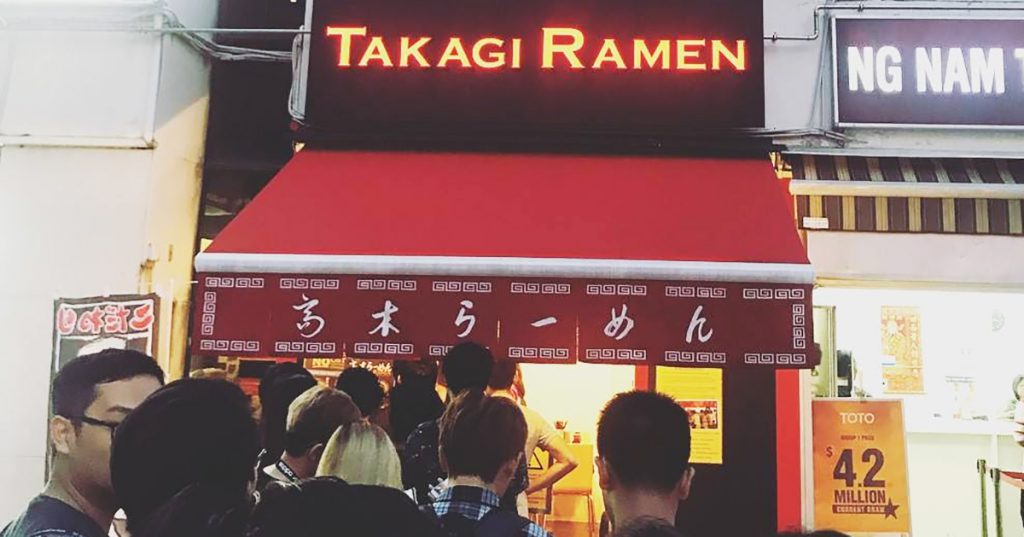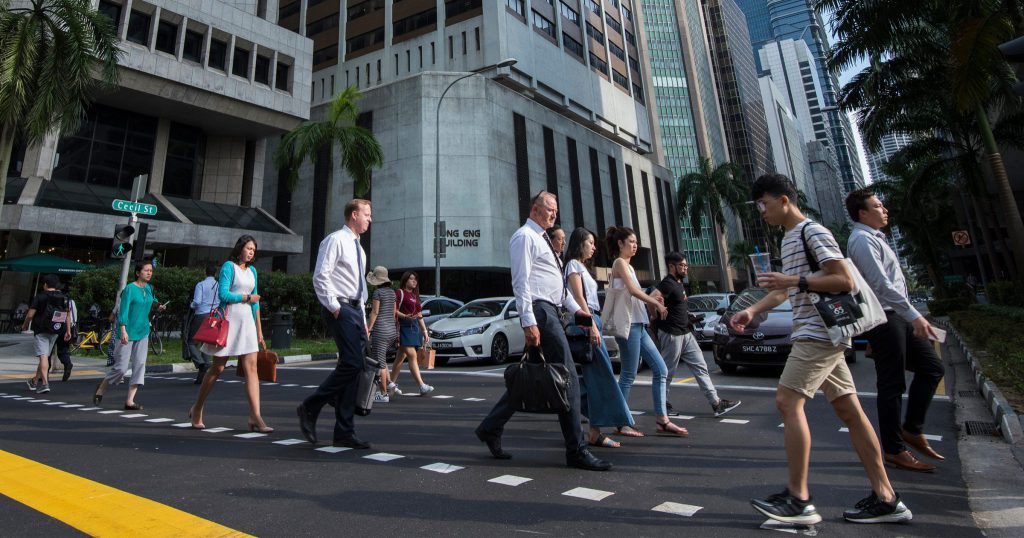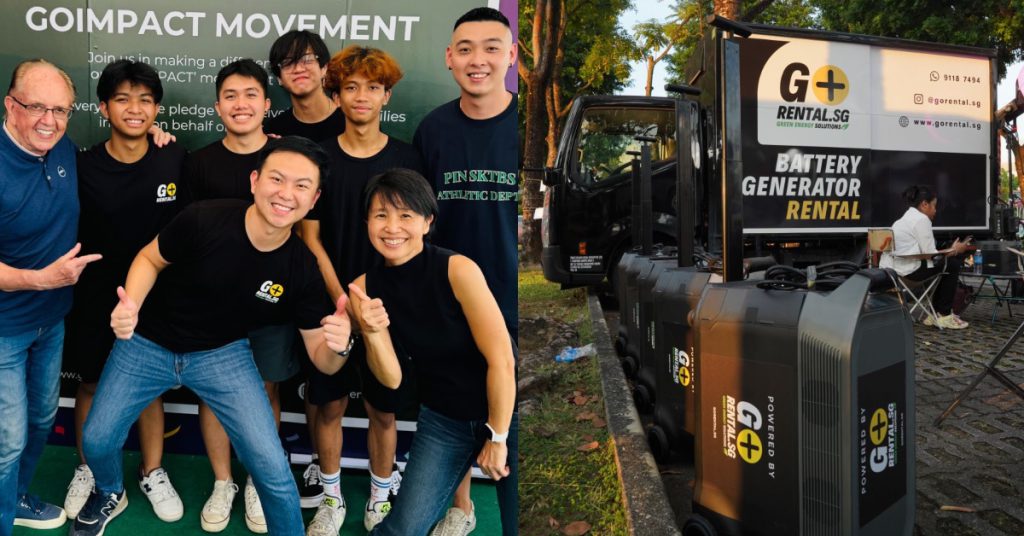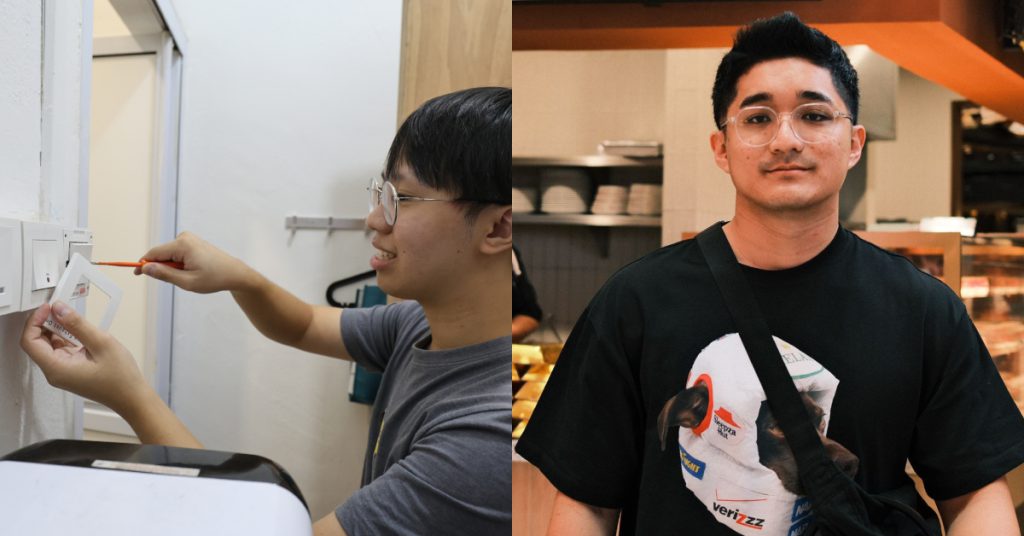We don’t get awesome, cooling weather like Japan, but what we do have is a wide variety of Japanese cuisine in Singapore for us to choose from.
But Japanese food here can be rather pricey, especially ramen.
Despite that, we can’t deny a hearty bowl of springy noodles in thick pork or miso broth, served with a few slices of melt-in-your-mouth chashu.
If I could, I would eat a bowl of happiness- I mean, ramen everyday.
But at what cost?! I think to myself, as I empty my wallet to satiate my cravings for such an atas comfort food.
When Takagi Ramen Shop popped up on our radar, I knew this was the answer to all ramen-lovers and budget foodies out there like me.
Ramen Is The Best Kind Of Men
If you haven’t heard, Takagi Ramen Shop (TRS) serves Hakata-style ramen at a really affordable price of $5.90 a bowl NETT.

The business is run by Yang Kaiheng (30) and his wife, Ai Takagi (25).
Both of them had no prior experience in the F&B industry. Kaiheng majored in environmental science while Ai put her studies in law school on hold.
But this lack of experience didn’t stop them from pursuing their passion.
They were university students in Australia when they met and the idea of selling affordable ramen in Singapore was already imprinted in their heads then.
“Ramen is the food we both love the most, and whenever we go to Japan, we like going into the many small shops along the street and eating a bowl as a snack or a simple meal,” Kaiheng told me.
[But] in Singapore, ramen is mostly served in restaurants and compared to local food, it’s easily double or triple the price of local noodles.
“We wanted to introduce ramen as an affordable food that Singaporeans could enjoy regularly – like a bowl of bak chor mee.”
“We are committed to being affordable and don’t want to pass on costs to consumers.”
“For example, we absorb all the taxes like GST so customers pay only what they see on the menu. We [also] do not believe in surcharges even when we are faced with supplier price hikes during holiday season,” he added.
They reinvented their processes to cut costs in areas such as manpower by keeping the team lean, and by doing everything by themselves at the start.
Happy Staff = Successful Business
“Working hours in the F&B industry are long, so we have optimised our process so that staff don’t need to come too early to stay back too late after closing,” he described.
“Now, at Ang Mo Kio, our staff typically go home just 15 minutes after we take the last order as we have simplified our closing procedures and have a good pre-closing SOP in place.”
The busiest time for TRS is dinner, especially on the weekends, when they can serve over 200 customers in three hours at their Ang Mo Kio outlet and a 100 at their Jurong West outlet.

For the owners, staff need to be good at multi-tasking as they are taking and making orders non-stop.
They also have to take note of special requests, pack delivery orders, top up supplies, and take ad hoc customer requests like noodle refills, which TRS gives free-of-charge.
“We believe happy staff are a vital part of running a successful F&B business so we ensure staff are properly rewarded.”

“Every month, we share 10% of our company’s profits with all our staff.”
Cloudy With A Chance Of Cha Shu
The couple are no strangers to starting up.
Kaiheng and Ai are the founders of the now-defunct online publication, The Real Singapore.
On why they decided to venture into ramen-making, Ai candidly shared, “We decided that we wanted to open our own business because our income options were also quite limited due to our high-profile [The Real Singapore] case.”
“Also, we had quite a large financial burden, given that Kaiheng’s father’s suffered from a rare medical condition known as ‘locked-in’ syndrome following a serious brainstem stroke. The medicine and care cost is around $5,000 a month and as an only child, the burden to continue taking care of him is all on Kaiheng.”
She added, “Furthermore, we had to pay off our debt to Singapore Press Holdings for copyright infringement.”
Now that the debt is all cleared, despite the high financial stress of living in Singapore, we are definitely feeling a lot more relief now.
Kaiheng echoed her sentiment, saying that out of all their limited options, opening a “traditional F&B business” was the long-term solution to drawing a steady income.
“It was a win-win for us that we were able to create an honest living doing something we were really passionate about – serving Singaporeans with value-for-money ramen,” he remarked.
The couple’s business was launched in 2015, when they opened their first stall in the National University of Singapore’s (NUS) Bukit Timah campus.
They chose “a low-cost location” in a food court on the NUS campus because they felt that “even if [they] didn’t do well, [they] would be able to cover the losses”.

Kaiheng revealed that they spent about $15,000 to start up, including the deposit and advance on rent, and kitchen equipment.
Business was brisk in the first few months, but they lost all their profits when the school holidays came.
However, they didn’t give up.
“We put in more money again to open a second outlet in a coffeeshop in Ang Mo Kio. Business at this location was a lot better and we were able to break even on the cost of this outlet within 3 months.”
“Business stabilised further when we shifted the NUS outlet to the main Kent Ridge campus as we had quite a steady crowd from the people working at Science Park nearby.”
“We are glad Singaporeans appreciate what we do, which I think is also why business has been getting better every day for the past three years,” Kaiheng quipped.
In 2017, they opened their 3rd outlet at Jurong West.
Making Memories With Ramen
Without any experience in running an F&B establishment, they faced a tremendous amount of challenges at the start.
As they didn’t know how to maintain their equipment properly, they “wasted a lot of money on repairs”.
Even cleaning equipment and washing dishes took a long time as we didn’t know the proper way to wash them quickly. It’s very different from washing up at home as the sheer volume can be overwhelming at the start.
In their early days of running the business, he recalled finding themselves still washing the dishes at midnight.
They also frequently slept overnight in the food court because they had problems with preparing the soup for the next day.
As their Tonkotsu soup requires boiling over high fire for 12 hours, they often burnt the soup and had to start over on several occasions.
However, the food court management was kind enough to pass them a key to the food court so they could get in and out at odd hours.
They also faced manpower issues, another common problem among small business owners.
For them, this was made worse by the challenging conditions at coffeeshops.
Kaiheng told me that on a hot day, the air near the pots of soup can reach a temperature of 60 degrees!

“We also had many staff who came for work for one or two days and then disappear as they found our kitchen too hot,” he said.
“The most memorable one was this staff who disappeared in just two hours. We had already showed him our kitchen and had given him our uniform,” he recalled.
Two hours later, he said he wanted to go to the toilet – and that was the last time we saw him.
They have since improved their staff welfare and working environment, so their manpower turnover rate is “now much lower than the industry standard”.
“The start was filled with weeks of sleepless nights,” Kaiheng explained, but their staunch belief in their mission to bring affordable ramen to Singaporeans led them to persevere and he shared that they “don’t have such problems now”.
“A lot of people think running an F&B business is just hiring people to work for you and you just collect money [at the end of the day]. It is a lot more than that,” he said.

“We are constantly working on how we can bring affordable ramen to more Singaporeans, and at the same time, keeping our current workforce of 20 staff happy.”
The Future Of Takagi Ramen
Kaiheng revealed that this year, they are focusing on preparing the business for expansion and are aiming to open another store next year “probably somewhere in the East”.
They are also partnering a local tech company to do island-wide ramen delivery. Soon, customers will be able to order ramen directly on their website, and even get catering services from the team.
Since starting in 2015, Kaiheng reckons they have “probably served over 400,000 bowls” across all three outlets.
Revenue for the business in 2017 exceeded $1 million, and Kaiheng revealed they are projected to hit $2 million this year.
“Receiving compliments from customers, seeing regular customers returning, or even seeing people finish drinking our Tonkotsu broth in our stores reminds us that we have been able to bring a bit of happiness to each customers’ day,” Kaiheng said happily.
Check out Takagi Ramen’s website here, follow them on Facebook here, and on Instagram here.
This article was written in collaboration with Takagi Ramen Shop.










